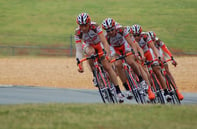Published on
Integrating 3D Objects and Animations into the Virtual Learning Environment

During the past several years, studies such as the Horizon Report and the GROE Roadmap for Education Technology have considered the benefits of three-dimensional learning environments (Johnson, L., Smith, R., Willis, H., Levine, A., and Haywood, K, GROE). Those environments include the use of 3D objects and animations, augmented reality tools, and collaborative virtual learning environments. In turn, recent surveys of faculty and students have considered the benefits of those applying those technologies in the traditional and virtual classrooms, as well as the willingness of faculty and students to use the technologies (Neill 2009).
When considering the application of 3D tools in the virtual learning environment, 3D objects and animations may offer the most promise. The use of those 3D tools in different learning environments takes advantage of our ability to see items extended in three spatial dimensions, and our ability to absorb and retain information gained through interaction. Achieving these visual factors and the resulting increase in learning and understanding can only occur through a higher level of realism. Cutting-edge 3D objects feature realistic perspective, texture and lighting, and increased detail. Standard computer products are able to present 3D animations in realistic frame rates, showing images that have smooth and realistic motion (Walker, 2009).
Given the attributes of 3D objects and animations, we can focus on both the benefits to cognitive learning when different 3D applications are used fit higher education needs, and the desire of faculty and students to work with 3D tools in the traditional and virtual classrooms. In terms of cognitive learning and 3D, students gain the ability to change viewing position or direction in order to move smoothly through the environment, or to examine or manipulate objects. Moreover, the capability of 3D animation to present objects that move autonomously allows the simulation of abstract characteristics difficult to visualize in the real world, or the description of complex content in different ways (3FX Inc., 2011).
The use of 3D objects and animations in the virtual environment may continue to increase because of ease of use and the opportunity for educators to build reusable learning objects. When compared to other immersive environments, 3D objects and animations allow the same type of control already associated with the typical use of a computer. A student can use a mouse to manipulate a 3D object or start and replay an animation. 3D objects or animations also work within lower-cost presentation software such as Articulate Presenter or Aurora 3D Presenter and within standard document files such as Adobe Acrobat (Moxon 2009).
Although learning management systems such as Blackboard do not support the direct interaction with 3D objects and animations, instructors can embed those objects or animations within other applications and then attach the files as items or hyperlinks. However, one key challenge with the application of the objects or animations is the selection of software that will support various 3D file types. Another is the development of manageable 3D learning objects that will not overload a learning management system. Both of these challenges have solutions. When these challenges are out of the way, the 3D object or animation can become a supplemental tool that allows the virtual student to gain a rich educational experience similar to that found in the traditional classroom.
While the use of 3D objects and animation in the teaching of life sciences has gained recent attention, the use of 3D tools to teach about STEM activities, illustrate physics, or to bring history to life adds to the possibilities (Scheucher, Belcher, Baily, dos Santos, and Gutl). Corporations such as 3FX Inc. and 3D4Medical have begun to publish 3D objects and animations that demonstrate how diseases attack, show cellular structure, and illustrate human anatomy and physiology (3FX Inc., 3D4Medical.com). NASA offers a variety of downloadable 3D objects that an instructor could manipulate and add to courseware that focuses on spaceflight, robotics, and physics (NASA). At Fort Hays State University, we have recently begun a project that digitizes fossils in 3D for use by K-12 students, university students, and researchers. All these activities and other potential uses for 3D objects and animations add to the richness of the virtual learning environment.
– – – –
References
3D4Medical.com. Web. August 2011.
3FX Inc. “The ROMI of ‘3D Animation & Environments’ for Life Science Education and Cognitive Learning. ” Conshohocken, Pennsylvania. 2011.
Global Resources for Online Education. “The Roadmap for Education Technology.” Global Resources for Online Education. Amherst, Massachusetts. 2010. Web. August 30, 2012.
Johnson, L., Smith, R., Willis, H., Levine, A., and Haywood, K., (2011). “The 2011 Horizon Report.” Austin, Texas: The New Media Consortium.
Moxon, Dave. “Dave Moxon’s Articulate e-Learning Blog.” August 29, 2011. Web. September 3, 2012.
NASA.com. “3D Resources Page.” Web. July 6, 2011.
Neill, Sandra. “Measuring the Teaching Effectiveness of 3D Learning Objects.” January 2009. Canadian Network for Innovation in Education (CNIE) conference, Ottawa ON May 2009. Web. September 20, 2012.
Scheucher, Bettina, Belcher, John W., Bailey, Philip H., dos Santos, Fabio R.,Christian. “Evaluation Results of a 3D Virtual Environment for Internet-accessible Physics Experiments. Interactive Computer-aided Learning Conference. Villach, Austria. September 23-25, 2009. Web. October 2, 2012.
Walker, Victoria. Traditional and 3D Virtual Learning Activities: Evaluating Cognitive, Affective, and Psychomotor Learning.” Paper Prepared for the Learning Technologies Conference: “The Power of You,” Mooloolaba, Queensland, Australia, November 19-20, 2009. Virgina Beach, Virgina. 2009. Web. October 1. 2012.
Author Perspective: Administrator


